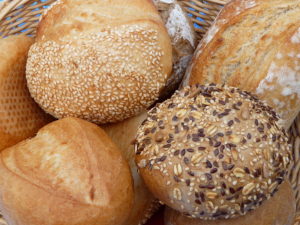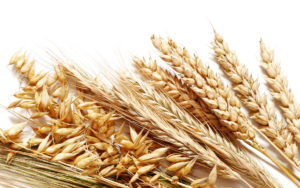 Another study finding health benefits of a fiber rich diet, which means lots of fruits, vegetables, whole grains, legumes (beans), nuts, and seeds. This time, researchers doing an a analysis of 2 studies lasting over a number of years found that there was an association with more fiber in the diet and less risk of developing knee osteoarthritis pain and of knee osteoarthritis symptoms worsening. The highest fiber group reported eating a median (middle number) 25.5 grams of fiber per day, while the lowest fiber group had a median of about 9 grams of fiber per day. They found a dose dependent relationship - the more fiber, the less osteoarthritis knee pain, and vice versa (the less daily fiber, the more they reported knee pain worsening) - this is called a "dose-dependent inverse relationship". The average fiber intake for Americans is about 15 grams per day.
Another study finding health benefits of a fiber rich diet, which means lots of fruits, vegetables, whole grains, legumes (beans), nuts, and seeds. This time, researchers doing an a analysis of 2 studies lasting over a number of years found that there was an association with more fiber in the diet and less risk of developing knee osteoarthritis pain and of knee osteoarthritis symptoms worsening. The highest fiber group reported eating a median (middle number) 25.5 grams of fiber per day, while the lowest fiber group had a median of about 9 grams of fiber per day. They found a dose dependent relationship - the more fiber, the less osteoarthritis knee pain, and vice versa (the less daily fiber, the more they reported knee pain worsening) - this is called a "dose-dependent inverse relationship". The average fiber intake for Americans is about 15 grams per day.
The researchers also found that the more fiber in the diet, the lower their Body Mass Index (less weight) - but they say they took that into account in the analyses, and found that the amount of fiber intake was the most important thing regarding knee osteoarthritis pain. Interestingly, they did not find an association of fiber intake and x-ray evidence of osteoarthritis. Note that this was an observational study - it observed that certain things go hand in hand, but it doesn't prove causation.
Osteoarthritis (OA) is common among adults aged 60 years and older, and is sometimes called "wear and tear" arthritis because it affects the joints. It causes pain and limits a person's physical functioning. There is a strong association between obesity, inflammation, and knee osteoarthritis. Obesity causes both inflammation and puts extra weight on the knees, and inflammation results in more joint pain. On the other hand, a high fiber diet reduces inflammation. The researchers point out that the data shows "a consistent protective association" between fiber in the diet and symptoms of knee osteoarthritis (no matter if you're overweight or not). IN SUMMARY: Eat lots of fruits, vegetables, legumes, whole grains, and nuts! From Science Daily:
Fiber-rich diet linked to lowered risk of painful knee osteoarthritis
A fibre-rich diet is linked to a lowered risk of painful knee osteoarthritis, finds the first study of its kind, published online in the Annals of the Rheumatic Diseases. The findings, which draw on two different long term studies, are broadly in line with the other reported health benefits of a fibre-rich diet. These include reductions in blood pressure, weight, and systemic inflammation, and improved blood glucose control.
The researchers mined data from two US studies in a bid to find out if dietary fibre might have any bearing on the risks of x-ray evidence of knee osteoarthritis, symptomatic knee osteoarthritis (x-ray evidence and symptoms, such as pain and stiffness), and worsening knee pain. The first of these studies was the Osteoarthritis Initiative (OAI). This has been tracking the health of nearly 5000 US men and women with, or at risk of, osteoarthritis since 2004-6 (average age 61), to pinpoint potential risk factors for the condition. The second was part of the Framingham Offspring cohort study, which has been tracking the health of more than 1200 adult children of the original Framingham Heart Study and their partners since 1971.
Analysis of the data showed that eating more fibre was associated with a lower risk of painful knee osteoarthritis. Compared with the lowest intake (bottom 25 per cent of participants), the highest intake (top 25 per cent) was associated with a 30 per cent lower risk in the OAI and a 61 per cent lower risk in the Framingham study. But it was not associated with x-ray evidence of knee osteoarthritis. Additionally, among the OAI participants, eating more fibre in general, and a high cereal fibre intake, were associated with a significantly lower risk of worsening knee pain.
This is an observational study, so no firm conclusions can be drawn about cause and effect. Nevertheless, the researchers say: "These data demonstrate a consistent protective association between total fibre intake and symptom-related knee [osteoarthritis] in two study populations with careful adjustment for potential confounders." [Original study.]

 A second study was just published about the benefits of eating whole grains daily - again a significantly lower risk of premature death, and again the effects were dose-related. That is, the more whole grains eaten daily, the lower the risk of early death. Like the
A second study was just published about the benefits of eating whole grains daily - again a significantly lower risk of premature death, and again the effects were dose-related. That is, the more whole grains eaten daily, the lower the risk of early death. Like the  This study, like previous research, found an association between increased
This study, like previous research, found an association between increased  My last post
My last post